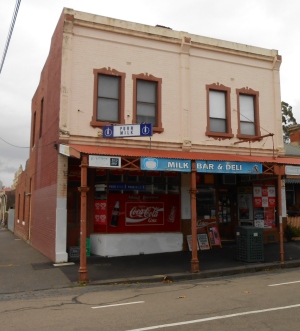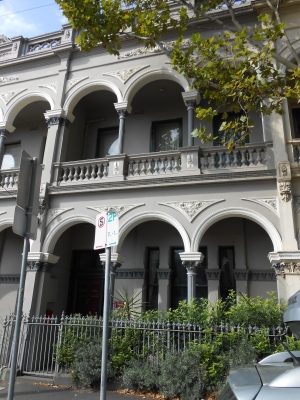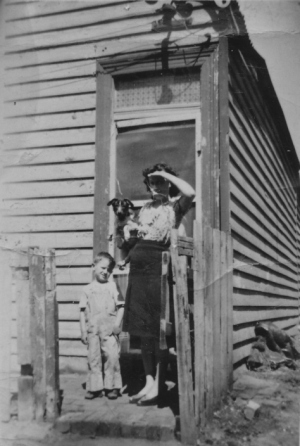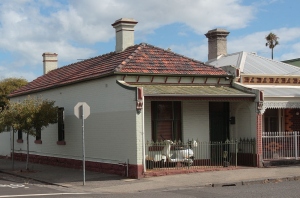Record Your Memories
If you have the equivalent of Aunty Betty in the Melbourne Times story, don't let that person die without telling their story. We have members who would be delighted to interview people if you don't feel confident. We are also delighted to receive stories if you have already collected them. Contact us now.
1 The Melbourne Times, 14 April 2010, p. 10
A Hole in Her Stocking
Read Bea's story and find out about the hole in her friend's stocking.
 Photo: CCHG Shops on Corner of Wilson and Paterson Streets, Princes Hill |
Mr Briggs' BusinessJohn, who lived in Wilson Street as a child in the 1950s, remembers the two shops on the corner of Wilson and Paterson Streets, Princes Hill. They were owned by Mr Joe Briggs who ran the corner shop as a grocery and rented out the one next door as a milk bar. I worked in the grocery as a child of six or seven. I packed sugar, oats, barley, rice etc. The bags were sealed by folding the top in a particular way and did not leak. The pay was good, broken bikkies from the tins, no packets in those days. His long-serving assistant was Mr Taylor and he was not so happy to have me around. Joe Briggs lived in a house in Macarthur Street, Carlton and rode a pushbike to Princes Hill daily, rain, hail or shine. He always wore a three piece suit and a heavy overcoat and hat, summer and winter, saying: "What keeps out the cold keeps out the heat." I used his bike for deliveries sometimes. It had a small front wheel and a huge metal basket over the wheel. Joe Briggs was friendly with my parents and was often invited to dinner. In the early 60s he convinced my parents to buy the shops, however, he died just before signing the sale documents. They waited months for the estate to be settled. We always thought the only counter space was about two metres long but when we finally got into the shop we found the counter ran the full length of the shop and returned across the back. More like twenty metres than two metres. The rest was stacked floor to ceiling with wooden crates of tinned goods, 99% were puffy & no good. He must have purchased the tinned goods pre or during WWII, maybe on the black market.
|
 Photo: CCHG 158 Nicholson Street Fitzroy |
Memories of 158 Nicholson Street, Fitzroy, in the 1950sFor much of the twentieth century many of the rather grand two storey Victorian terraces at the southern end of Nicholson, Rathdowne and Drummond streets served as rooming houses, where tenants rented individual rooms and shared kitchen and bathroom facilities. Jack*, a Carlton resident for more than 50 years, has provided us with this account of his first home, just across the road on the Fitzroy side of Nicholson Street very close to the Carlton gardens. This was a rooming house then when Fitzroy was a very poor and rough area. Many people lived in the house, one or two to a room. My mother and I were in the second room from the front upstairs. A migrant man lived in the front room. He was very nice but tried to seduce me once. I was seven. On the landing was a stove used by the upstairs tenants. Next room back was the bathroom used by the whole house. We always cleaned it before we used it as no one else did. Cooking pots and dishes all had to be taken to the bathroom and washed in the hand basin. Mother complained about having to carry the heavy pressure cooker to the bathroom which necessitated going down some stairs and up another lot. Several more rooms upstairs were all individually let. The toilet for everyone was at the back of the yard downstairs. I rarely left the room except to go to school. Downstairs the front room had an older couple. He would drink heavily on a Saturday night and the woman would become frightened as he always came home when the hotel closed and beat her. The whole house could hear this. It seemed to be accepted. The house was owned by an elderly couple but leased by a rather sleazy man who rented several houses and sublet all the rooms. He was having an affair with the woman in the downstairs back room who paid less per week. My mother was disgusted by this. Mother worked long hours and as we had no other family she did not like me to walk to and from school alone as Fitzroy was rough. She would take me to school and I would wait (often in the cold or rain) for it to open an hour later. The same after school, I remember a lot of waiting, though I would read. We were very poor and seemed to be frightened a lot of the time as life was so precarious. Getting sick, missing work, not paying the rent would have meant eviction, a constant dread. Our room had two beds, a wardrobe, some chairs, a kerosene heater and a cord outside the window on which to dry clothes that had been washed by hand in the bathroom. We had an iron. Our lives were in the room. An unhappy time. All sounds very Dickensian. * Not his real name.
|
 Photo: Courtesy Ward Family 11 Henry Street North Carlton |
Henry Street and BeyondGeorge recalls growing up in Henry Street North Carlton in the 1950s as an exciting time in many ways. Being a dead end street, there was rarely a problem with playing football or cricket as we did not have passing traffic. One of the neighbours, Bert, was sometimes worried about us breaking his windows, so we would move down the street and continue the game. He worked at MacRobertson's chocolate factory, and sometimes brought home a box of Cherry Ripe off cuts that we got to share. Outside the street, there was the annual Whittingslow carnival held at Curtain Square. It had music, rides and bright lights. My grandmother and aunties, who lived in Fenwick Street, would meet us there and we would have a great time. There was also Anzac Day. The men would form up at the intersection of Rathdowne and Park Street and march down to the hall in Princes Street where they had a service. Us kids would march behind and those who got to sit on the floor down the front were given food and drink. Then there was cracker night. Two in fact. We would spend the days before gathering wood etc for the big night. We tried getting trees from the cemetery but it was often too green to burn. There was also the pictures at the Adelphi Theatre on Saturday afternoon. Sometimes for a change we would go to the Palace Theatre in North Fitzroy. Nine pence to get in, 3 pence for an ice pole. A great day out for a shilling. If you had extra money, potato cakes at 1 penny each on the way home were great. On other days we would go yabbying at the Exhibition Building and when we got bikes we would ride to the Merri Creek to catch yabbies. The idea was to catch them on the Saturday and take them over to Zoo and sell them on the Sunday, I am not sure that it ever worked. Then there was always the football. The grounds would let you in free for the last quarter. Sometimes we would collect the beer bottles and take them up to the bottlo and sell them after school on the Monday. He would pay 10 pence a dozen, as against 6 pence a dozen if he had to collect them from our homes. Soft drink bottles were somewhat prized as most milk bars refunded 3 pence per bottle. What a busy life we had, I am not sure how we had time to go to school.
|
 85 Macpherson Street North Carlton |
A Dairy and Forge in Amess Street1 The house was built by John Howell in 1888-89 and was later owned by John Pigdon Jnr, son of former Melbourne City Council Mayor John Pigdon. |
Dinnie O'Brien was born in Springmount, a small country town near Ballarat, on 13 December 1905. In 1917 his parents' hotel was burned down and the family and their 13 children moved to Carlton. In 1935 Dinnie and his own family moved to 387 Station Street, North Carlton and bought a wood yard at 84 Neill Street. The business not only sold wood and ice but also moved furniture for people. In 1958 he sold the business and moved to 466 Canning Street. He then became the local bottle-oh and collected beer bottles in a horse and cart. He was extensively involved in charity work organising pony rides as fund raisers for local kindergartens and St Brigid's Parish. He was an avid Carlton Football Club supporter and a fan of Carlton, the suburb where he worked for over 35 years. O'Brien Place, a laneway in carlton, was named after him following his death, aged 80 in 1986.
Rhonda remembers her grandmother teaching her to read from gravestones in the Melbourne General Cemetery and taking her to the public library to search for information when children were not usually welcomed in such places. She and her grandmother attended society weddings, Sir John Monash's funeral in 1931 and watched people going into the mayoral ball, all at least as far as the steps. It was novel entertainment. Her grandmother also taught her to cook so she could cook dinner for her grandmother's lodgers when she went into town to 'have tea with Lena'.